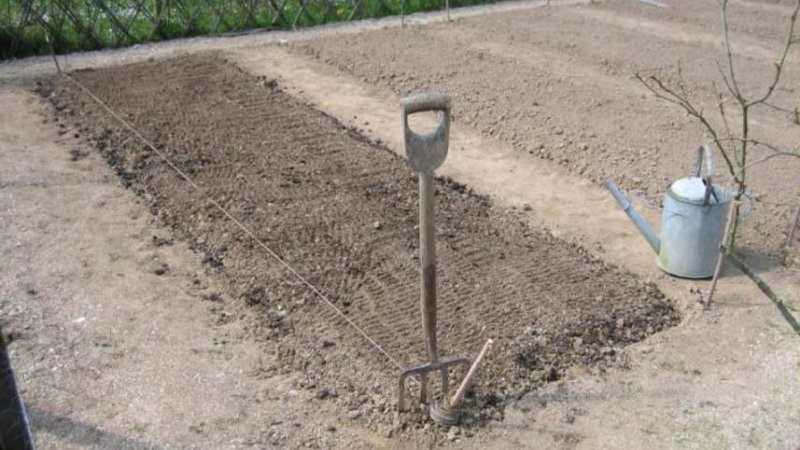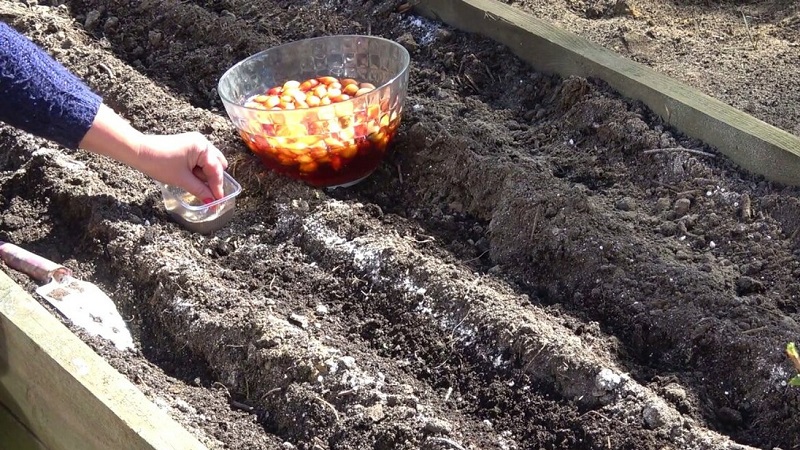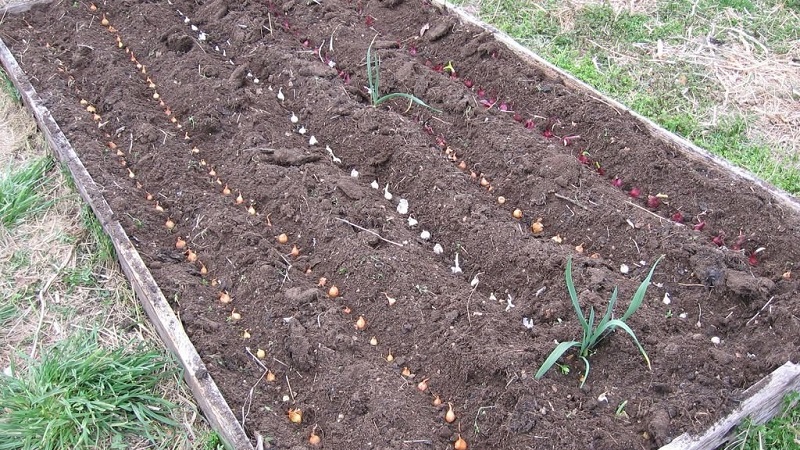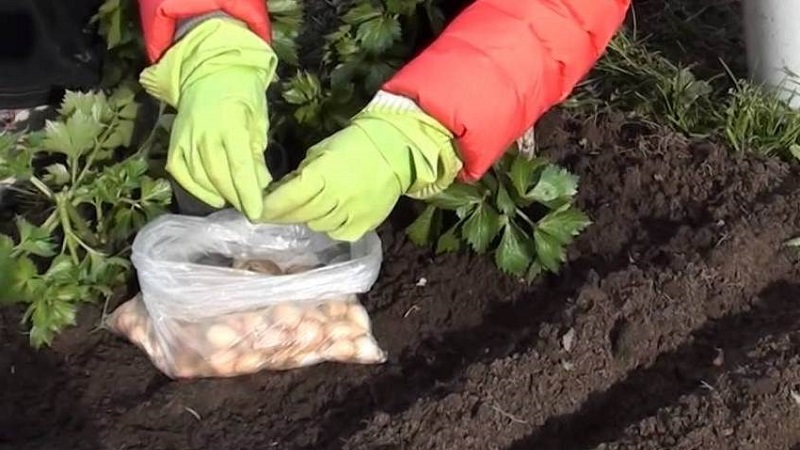Step-by-step instructions for preparing a bed for onions in the fall
When planting onions in winter, it is possible not only to get an early harvest, but also to save time for caring for the plants. Although this culture is unpretentious and cold-resistant, so that the turnips do not freeze and deform, it is important to properly prepare the site before planting.
The content of the article
Why prepare the beds for the winter
Onions are a hardy plant, but for full development they need certain soil structure, sufficient nutrients, moderate moisture. This will ensure good yields and survival of the crop in frosty conditions.
Site preparation includes:
- loosening:
- weed removal;
- fertilization;
- regulation of acidity and soil structure;
- mulching.
If these measures are not taken, there is a high risk that the onion will not sprout..

When to cook the beds
Specific dates depend on climatic conditions. In this case, the following are taken into account.:
- The onion must have time to take root, but not sprout, otherwise the feathers will die in winter, the plant will freeze or be seriously oppressed.
- Dryness is better than rain: a dry bed is watered, and onions will rot in waterlogged soil.
Winter crops are planted about a month before frost, therefore, the terms for preparing the beds are as follows:
- in the Moscow region and central Russia - mid-October;
- in the south - mid-late November (in Crimea and the Caucasus - early December);
- in Siberia, the Urals and in the northern regions of the European part of the country - September.
Wherein it is important to follow forecasts of weather forecasters.
Interesting on the site:
Winter varieties of onion sets for planting before winter
Preparing the beds for onions in the fall
To get a rich harvest of vegetables next season, they begin to prepare in the fall.
Weed control
The winter onion plot is thoroughly cleaned of:
- plant residues from the summer: tops, roots, rotten fruits;
- weeds: green mass is dangerous, on which pests remain.

Use herbicides if necessary... So, if the site was infected with wheatgrass, there is no other reliable way to completely get rid of it.
Attention! When processing a site with such means, the standards established by the manufacturer are observed. Sowing onions too early will absorb toxic chemicals.
Digging
Onions, both in spring and autumn planting, need loose and aerated soil.... Therefore, when laying out the beds and preparing for sowing, the soil is loosened at least with a bayonet.
How to prepare a virgin land where nothing has been grown before? To do this, use double digging.:
- Take a sheet of iron, plywood, or a wide piece of film.
- The top layer of soil is torn down on a bayonet into the depths, the removed soil is laid aside on a sheet or film.
- The exposed soil is dug again onto the bayonet of the shovel.
- The resulting cavity is covered with removed and crushed earth, which is rubbed with gloved hands.
This technology is suitable for heavy black soil with a thick humus layer (for example, as in the Voronezh or Tambov regions). If the humus is less than the bayonet of a shovel, this method will only raise a lifeless layer of clay or sand. If in doubt, the earth is drilled or a sufficiently deep hole is dug to the side.

When digging, raise the level of the beds, throwing soil on them from the paths formed along the perimeter.Ideally, the garden bed should rise by 12-15 cm so that excess liquid is drained along the paths around and the area does not become waterlogged.
Enrichment of soil composition
When planting onions in autumn, only biohumus is used (such as arising from growing California worms), well-processed compost, or grass-fed peat.
In addition to organic matter, synthetic fertilizers are also introduced into the soil. (dosage per 1 m2):
- urea - 25 g;
- superphosphate - 15–20 g;
- potassium chloride - 20 g.
Wood ash is pre-added at the rate of at least 15 g per 1 m2 beds... This tool is used in any quantity: the surplus simply will not be absorbed and will remain in the soil for the future.
Read also:
Change in soil structure
Onions have weak roots, so they need loose and well-aerated soil.:
- When grown on sand or sandy loam, clay is preliminarily introduced to hold the soil together. The amount of the substance depends on the composition of the soil, but usually 1 bucket per 2 m is enough2.
- On loam, heavy chernozems and similar soils, sifted and well-calcined fine river sand is added (1 bucket per 1 m2). It will make the soil looser and more airy.
- The vegetable prefers chemically neutral soil, therefore, before sowing, a lump of soil is placed in warm water, left for a couple of days, filtered and the acidity is checked with litmus paper. At low pH values, lime or chalk is added to the soil. At high rates, sawdust is added. The optimum pH for onions is 7.5.
If the soil structure and acidity are normal, the culture is immediately planted.

Mulching and other procedures
After fertilization, the soil is disinfected, especially if earlier on the site there were outbreaks of gray rot, powdery mildew, rust, fusarium. To do this, use a solution of copper sulfate (2 tablespoons per 10 liters of water). Consumption: 1 bucket per 1 m2... The agent destroys fungal spores, preventing infection of the onion plantation.
Important! Together with fungi, vitriol also kills soil bacteria, therefore, disinfection is carried out no more than 1 time in 3-4 years. In the spring, the beds are spilled with a solution of "Fitosporin" or another biological product.
After planting the onions, the beds are mulched straw, hay or dry plant stems. The layer is made 10-15 cm thick.
Features of the preparation of beds and seeding
For onions, the plot is prepared taking into account such requirements:
- loosening depth - at least 5 cm deeper than the root growth zone in adult plants;
- the garden bed is raised so that the seeds do not rot.
Preparing onion sets for planting includes:
- careful selection: all damaged, rotten or diseased specimens are disposed of;
- disinfection: to avoid rust and rot, the seed is soaked in a solution of potassium permanganate, copper sulfate or a complex fungicide.
When planting in the fall, lay 10-15% more seedlings in case of the death of his unit.

Tips from experienced summer residents
The technology of cultivation of autumn onions is not difficult, but little tweaks will increase yields:
- When laying out the beds, the furrows are made in such a way that they stretch from north to south. This will improve the illumination of the plants and the rate at which the soil warms up in spring.
- The site is chosen on a hill, not in the shade. So the soil will warm up faster in spring, and the seeds will sprout earlier.
- Onions are not planted for 2 years in a row in one place or after garlic.
- Zucchini, carrots or greens are planted next to the winter crop.
Conclusion
Planting onions before winter is a popular cultivation technology. To prevent vegetables from dying in frost, it is important to properly prepare the site. To do this, it is cleaned of plant residues, thoroughly dug up, and nutrients are added.
If required, the acidity of the soil is corrected with chalk or sawdust. After planting, the seed beds are mulched with straw or hay.